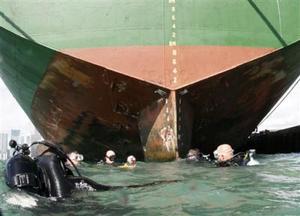Container securityICE dive unit targets drug smuggling containers
The intense law enforcement focus on drug trafficking through Mexico could push some cocaine smuggling operations to U.S. coasts and ports; in an effort to prevent another era of “cocaine cowboys” in Miami, circa the 1980s, U.S. officials are not leaving the security of ports and international maritime shipments to chance; “If you cut off one way for drugs to get in, they will find another way,” one ICE agent said

ICE divers searching suspected smuggler ship // Source: dailybreeze.com
The seven members of the U.S. Immigration and Customs Enforcement dive team, formed in 2004, and the only one of its kind in the United States, regularly searches for large metal boxes that Latin American cocaine traffickers sometimes weld or clamp onto freighters and even cruise ships to smuggle drugs. The boxes also could be used to hide terrorist bombs or weapons.
The team of divers recently investigated the bottom of the 498-foot container ship M/V Seaboard Pride in Miami for the so-called “parasitic” devices that are being used to smuggle drugs and potentially, terrorist bombs or weapons.
Once in this country, the boxes can be opened by divers working with the drug organizations. Sometimes they are detached and later opened at another location. The devices have been found on vessels in Miami, West Palm Beach, and elsewhere containing bricks of cocaine and other illegal drugs - although, so far, no bombs or weapons.
ICE agent Dean Lang, assistant chief of the dive team, said the intense law enforcement focus on drug trafficking through Mexico could push some cocaine smuggling operations to U.S. coasts and ports. In an effort to prevent another era of “cocaine cowboys” in Miami, circa the 1980s, U.S. officials are not leaving the security of ports and international maritime shipments to chance.
“If you cut off one way for drugs to get in, they will find another way,” Lang said.
When agents first boarded the white-and-green Seaboard Pride, they informed its captain of the random check and secured all machinery so none of the thirteen mainly Filipino crew members would inadvertently start a propeller or pump. The captain, Dariusz Karbowiak, said he had just unloaded a dozen 40-foot containers of fruit and seafood and did not suspect anything illegal.
“It’s no problem. We have no problem,” said Karbowiak, 42, who is from Koszalin, Poland. “I don’t have any events where I suspect something wrong.”
The ICE agents quickly obtained blueprints of the ship’s hull. With two agents staying aboard, the divers jumped feet-first off a sea wall into Biscayne Bay to execute a search known as a “half-necklace” - meaning they would swim underneath one side, circle the ship’s stern by the massive propeller and then inspect the other side. They held a length of rope to communicate with various hand tugs and pulls.
“Don’t squeeze too tight,” the ICE dive team leader, agent Joseph Skidmore, told the men. “Just keep a loose grip.”
It is
